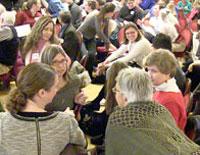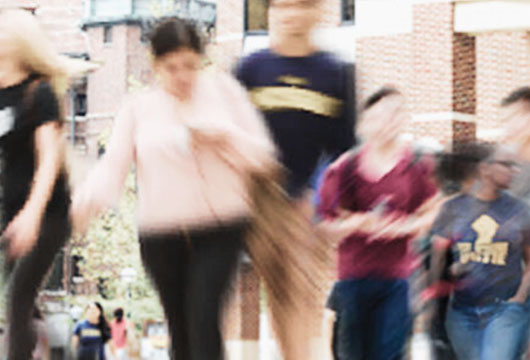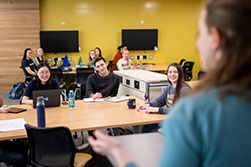At his recent presentation in the Michigan League ballroom, Harvard physics professor Eric Mazur engaged the 250-person audience in an active learning exercise. An expert on the use of peer instruction in college courses, Mazur wanted the many teachers present to experience the power of this pedagogical strategy from a student perspective. So, using an example of question-based instruction from his own field, he provided a very brief explanation of thermal expansion, posed a multiple choice question that required application of the concept, and then guided those present through a 4-step exercise:
- Think silently about the question
- Commit to an answer (in this case, by using clickers)
- Find another 'student' who had a different answer and discuss the thinking behind each answer
- Answer the question again.
The second set of answers was significantly more accurate than the first. Such a result generally follows such a peer instruction protocol, as much research has shown. Why? Through discussion, students shift their focus away from the answer itself and toward the thinking behind the answer, and those with the more accurate logic are generally able to make a more persuasive case. The demonstration also powerfully illustrated how such a technique can engage students emotionally as they become personally invested in learning and understanding the correct answer. The discussion created remarkable buzz in the room about thermal expansion--a topic that Mazur noted would unlikely generate such excitement if simply explained in lecture format. (You can get a sense of that buzz by watching a video of the event.)
In discussing the peer instruction technique, Mazur highlighted several strategies that can help engage all students in active learning, even in a very large course. These included:

Requiring that each person find a partner who chose a different answer to the multiple choice question. This requirement (provided the question successfully generates divergent answers) validates trial and error by anticipating a significant proportion of initially incorrect responses. Such practices that normalize challenge and frame learning as a process include students with a range of background preparation in the learning community. They can also help fend off stereotype threat by casting any student struggles to learn as an effect of the complexity of the material rather than the deficiencies of the student. (Carol Dweck's research on mindsets offers further insights about the usefulness of normalizing challenge as part of the learning process.)
Instructing participants to seek out a next partner for discussion if resolution had been reached in the initial pair. In Mazur's own classes, students are told that the professor or a GSI will pair up with them if they are not speaking with a peer. Such reinforcement of the importance of every student's continued engagement sends a clear message that interactivity is a crucial component of the learning process in the class. This is an important message to send when using student-to-student learning of any sort, as we discuss in our recent blog post on teaching with student groups.
Other techniques teachers can use to help foster inclusivity while using student pairs include:
- Incorporating regular opportunities for students to meet new classmates, especially in large courses. This could be as simple as giving students time to introduce themselves to two new people at the beginning of each class meeting, a practice that can help move students to interact voluntarily with classmates beyond their normal social groups.
- Giving pairs a clear task, goal, and time frame. A structured activity and clear expectations about the outcome provide students a ready path to full engagement.
- Reminding students why you're using peer instruction in your course. When students understand the learning goals of a given activity, they will be more motivated to engage.
- Reinforcing the importance of the pair work by giving the class feedback on their engagement with a peer instruction activity. Whether it's simple affirmation that they all used the pair time well, or a reminder that they need to find partners more quickly, regular feedback on the process underscores its importance and fosters student engagement.
For more on peer instruction, see the Turn to Your Neighbor blog or the Mazur group website. For more on "Inclusive Teaching," click the tag below.
- Log in to post comments
- 135 views






